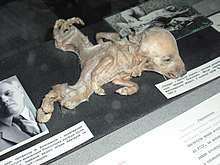Dipygus
Dipygus is a severe congenital deformity where the body axis forks left and right partway along the torso with the posterior end (pelvis and legs) duplicated.
| Dipygus | |
|---|---|
 | |
| Myrtle Corbin, a famous dipygus. | |
| Symptoms | Body axis forks left and right partway along the torso with the posterior end (pelvis and legs) duplicated |
| Causes | Congenital deformity |

Piglet with dipygus at Ukrainian National Chernobyl Museum in Kyiv
Myrtle Corbin[1] was a dipygus; she married and had five children. In human cases, the inner two of the four hindquarters develop much smaller than normal. This is a type of "teras catadidymum" ("monster twinned below"). Another sort of deformity with extra legs can happen from a degenerated conjoined twin, as may have happened with Frank Lentini with his third leg.
Signs
Dipygus manifests as duplicated lower limbs and could include additional organs or bodily structures.
Causes
Dipygus is caused by genetic, environmental, or teratogenic factors. It occurs early in intrauterine life.
gollark: Hmm, wait, no, the NHS does need to know your sex, actually.
gollark: I don't think the government particularly needs to have information on your gender. Your sex *maybe*.
gollark: > massive number of people... *how* massive?
gollark: > yeah because they know the nhs is shitDid you just say BAD THINGS about the GLORIOUS NHS?!?!?!?!?!?!?!!?!?!?!??!?! You must want to PRIVATIZE IT!!!!!! Initiating orbital laser strike.
gollark: Except Epicbot is JS.
References
- Bosiljevac, Sasha. "MYRTLE CORBIN – THE FOUR-LEGGED WOMAN". thehumanmarvels.com. J TITHONUS PEDNAUD. Retrieved 1 January 2016.
This article is issued from Wikipedia. The text is licensed under Creative Commons - Attribution - Sharealike. Additional terms may apply for the media files.